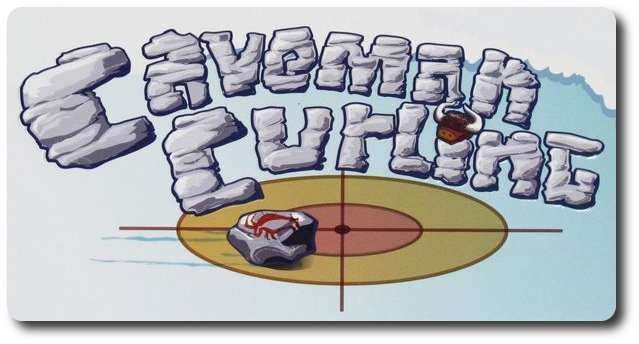
The Basics:
- For ages 4 and up (publisher suggests 7+)
- For 2, 4, or 6 players (teams)
- About 15 minutes to complete
Geek Skills:
- Counting & Math
- Logical & Critical Decision Making
- Hand/Eye Coordination & Dexterity
- Strategy & Tactics
- Risk vs. Reward
- Visuospatial Skills
- Cooperative & Team Play
- Hand/Resource Management
- Worker Placement & Area Control
Learning Curve:
- Child – Easy
- Adult – Easy
Theme & Narrative:
- Over 20,000 years ago, a bunch of cavemen and women got together and created a game. This is their story…
Endorsements:
- Gamer Geek approved!
- Parent Geek approved!
- Child Geek approved!
Overview
Me no want to play with just rock. Me want to play with rock and ice. Me want to push rock down ice and get close to fire. Fire is good. Rock is good. Fire and rock is more good. You play with rock on ice? You think you better? Me no think you are. Me bet my club on it. You bring rocks on ice and we have game. Winner get credit for inventing wheel.
OK. No more “caveman” speak. Me promise.
Caveman Curling is comprised of a beautifully illustrated paper board (more on this in a moment), 2 magnetic “slammer” clips, 12 “Rock” wooden discs (6 in red, 6 in tan), 4 Big Hammers (2 in red, 2 in tan), 4 Little Hammers, (2 in red, 2 in tan), and 4 Totem Tokens (2 in red, 2 in tan). In addition to the discs being wooden, the Hammers, and Totems are also made out of wood and are solid. The magnetic “slammers” are very durable, too. Caution must be used with the board, however. It is made out of thick paper, but paper all the same. Clearly not a game you let your 2-year-old set up or have precariously balanced beverages next to.
Game Set Up
To set up the game, unroll the board and clip the magnetic “slammers” on the ends of it. This will make it lay flat and provide a little weight to help keep it anchored down during the game. Next, separate all the tan pieces and the red pieces. Each player or team should have 6 “Rocks”, 4 “Hammers”, and 2 “Totems”.
For a 2-player game, one person will take the red pieces and the other the tan pieces. If playing a 4-player and a 6-player game, the two teams will divide the “Rocks”, “Hammers”, and “Totems” evenly among their fellow teammates.
Once the teams have been organized and game pieces assigned, have one player from each team engage in a skillful game of Rock-Fur-Hammer, a game that reportedly is the great-great-great-great-GREAT grandfather of the game Rock-Paper-Scissors. Whoever wins starts the game.
The Right Tools for the Job
Before you even approach the board and start to play the game, you best know what you are doing. There are several game pieces that are used in the game. If used right, they can make any game into a real nail-biter.
- The Rocks: these are the large wooden discs that will slide down the board towards the Cave. The more of these you get in the scoring zone (the Cave), the more points you stand to gain. The Rocks are also used to play offensively and defensively against the other player or team.
- The Hammers: the hammers come in two different types. These are the Big Hammer and the Little Hammer. These are used to move one of the Rocks that were just used by the player in any direction but only as far as the Hammer is long. To do so, place a Hammer (big or little) next to and touching the Rock. Then you pick up and move that Rock to the other end of the Hammer.
- The Totems: these are used to protect the player’s Rock that was just used and are placed on top of the disc. If the Totem should ever be removed by another Rock hitting it, the player can choose to leave the Rock where it currently is or pick it up and flick it again on their next turn.
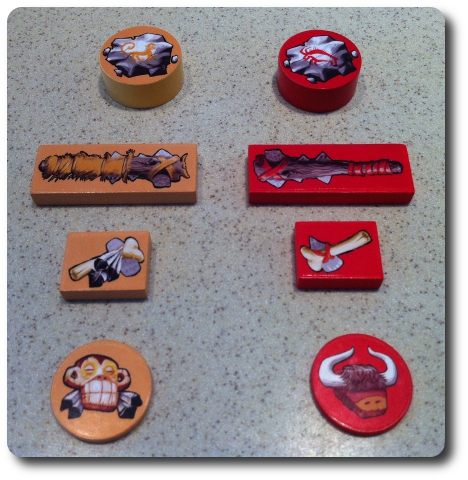
Starting at top: Rocks, Big Hammers, Little Hammers, and Totems
The Lay of the Frozen Land
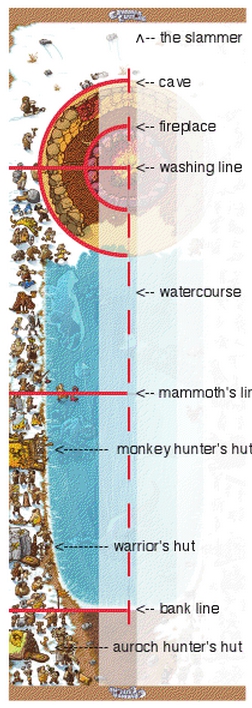
The game board
The board on which the game is played deserves special attention. Not only is it an absolute joy to look at (the colorful and comedic illustrations remind me very much of Martin Handford’s “Where’s Waldo” illustrations), but it is also where all the action of the game takes place.
The board is meant to represent a lane of ice. Anyone who is familiar with Curling (I live in Minnesota, so it’s kind of required), will immediately recognize how the game board is laid out.
- The Bank Line: this is the line where all players must flick their Rocks from. Any space behind the line and on the game board is considered a legal position.
- The Mammoth’s Line: this is the line where all Rocks must pass in order to be considered “in play” after it is flicked. Failure to move the Rock past this line will result in the Rock being disqualified and removed for the duration of the round.
- The Cave: this is where all the players are trying to place their Rocks. Only Rocks within the Cave will score points and only those rocks that are closest to the center (the fire) will score points for the player, with more points scored radiating outward from the Cave’s central point. Specifics on scoring are covered in “Counting Rocks” below.
There are a number of other areas on the board that do not influence the game, but can be used. For example, the Huts are used to hold unused Rocks, Hammers, and Totems, but this is not necessary. Use them if you think it will be easier for players and teams to keep track of their game pieces.
Caveman Style Curling
Teams will take turns to complete a game round, with each player having a chance to flick their Rock. There might be many game rounds or very few depending on how good the players are. On a player’s turn, they can take up to two actions in the following order:
- Throw the Rock: Well, not “throw”. The player will be flicking the Rock game piece by placing it anywhere behind the Bank Line on the game board. There are no specifics on how one should “flick” the Rock. Let the players decide how they want to do this and enjoy the variety. Players are welcome to change their style at anytime during the game if they think it is needed.
- Use Hammer or Totem: This is an optional action and can be skipped if the player wants. They can only use each Hammer (big or small) and the Totem once per round and only on the Rock they just flicked. Once used, they are removed for the duration of the round. In the case of the Totem, they remain on the board until the round is over or the Totem is knocked off the Rock it is currently placed.
When flicking the Rock, it must remain on the board at all times and go beyond the Mammoth Line. If the Rock should ever hit the board’s end slammer, the Rock is disqualified. Likewise, if the Rock is pushed off the board, it is disqualified. A Rock can also be disqualified if it is ever hit hard enough to cause it to flip upside down. All disqualified Rocks are placed to the side and not used again until the next round of the game.
Counting Rocks
Once all the players have flicked their Rocks, the round ends and the points are counted. Only Rocks in the Cave will count as points at the end of the round.
Determine which player has their Rocks closest to the center of the Cave (the fire). This player or team is the only one to score this round. They score a number of points equal to the number of Rocks in the Cave, moving outward from the center of the Cave. At anytime the other player or teams Rocks are the next closets Rock to the center while counting, no additional points can be earned. Confused? Don’t be. Take a look at the following image.
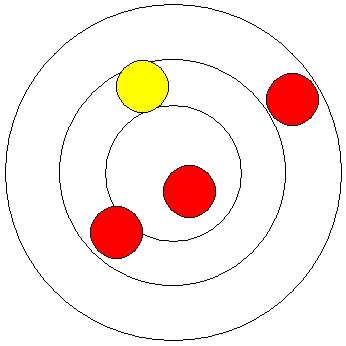
Using the above image, the player with the red pieces will only score 2 points at the end of the round. This is because the other player’s piece is the next piece from the center after scoring the two red Rocks. This means the scoring stops and the player’s third red piece is not counted. Simple!
Winning the Game
The game continues with a new round with all players taking up their game pieces and starting over with the player or team who scored the most points going first.
As soon as one player or team scores 6 points or more, the game ends.
The Mississippi Game Variant
When a player or team flicks a Rock into the Cave, the other player or team must flick their Rocks until they place a Rock in a better position (closer to the center of the Cave) or knock their opponent’s Rock out of the Cave. If the team uses all their Rocks, they are out for the duration of the round and the other player or team can now flick their remaining Rocks. Use of Hammers and Totems is permissible.
To learn more about Caveman Curling, see the game’s official web site.
Prediction
My little geeks love, love, love Shuffleboard. I don’t know why this is or how it even came to pass. One day, they just started talking about it…a lot. If I had to guess, an episode of “SpongeBob SquarePants” is most likely responsible. That animated sponge gives my little geeks strange ideas.
Once they universally decided that Shuffleboard was the greatest thing since Christmas, they were all for playing any games that involved the same type of game mechanisms. What games we had that fulfilled their needs were played to death. Once they were done with those, they ventured outside and created their own games. It was a whirlwind of activity at our house for about a week and then, just as quickly as it had started, it finished. As you can imagine, this left the parents perplexed but also grateful. The chaos was over, the storm had passed, and for the briefest of moments, everything was quiet. Quiet, that is, until the next storm hit.
When Caveman Curling came into my life, I had some reservations. First off, I wasn’t certain if my little geeks were even interested in this type of game anymore. They had long since moved on and were now into other things that were most likely causing micro disasters around my home. Second, I wasn’t all together certain I wanted to rekindle their strange obsession with Shuffleboard again.
When I presented Caveman Curling to them, they were unimpressed. They looked at the board, liked the art, but found the game pieces to be lacking in any real depth or interest. Exceedingly functional in their young eyes, but I doubted they were really “seeing” what the game was about. A quick demo was in order.
I put out the board and the game pieces and asked my little geeks what it looked like to them. They both just looked at it and gave me a blank stare. I then took one of the Rocks and flicked it down the board towards the Cave. Then another and another. My 4-year-old was the first to recognize the game and shouted, “It’s Shuffleboard, Daddy!” That’s when my 7-year-old smiled and started jumping up and down excitedly.
It takes about 2 minutes to explain how to play Caveman Curling. Yes, much, much, much less time that it took you to read this far and for me to write this review. I had my little geeks up and running, with no questions whatsoever on how the game was played or what they were attempting to accomplish, very quickly. Before we played, I asked each of them what they thought of the game so far.
“Cool! Cool! Cool!” ~ Liam (age 7)
“Play it where it lands, Daddy!” ~ Nyhus (age 4)
Clearly, my 7-year-old is in love with the game, but I have no idea what my 4-year-old is talking about. Again, I blame the sponge in the pants. Let’s play the game and see if their excitement fades.
Final Word
Admittedly, Caveman Curling is not doing anything new. There are a number of games available on the market today that use the same type of game mechanisms. For example, Sorry! Sliders and even the very old Crokinole. The game is original in its theme and use of special tools however, which will make players already familiar with flick-actions games happy enough to give this game a try. For the first time player of a flick-action game, Caveman Curling is going to be an automatic hit. Easy to learn and easy to play, with an excellent balance between skill and luck, where skill will greatly improve a player’s game play but not necessarily give that player a win.
My little geeks both did very well with the game and loved playing it, but both took different tactics in doing so. My 7-year-old did an excellent job demonstrating his use of worker placement and area control by creating barricades with his Rocks once he was able to get at least one in for scoring. He also used his Totems very well, almost always being given a chance to re-flick his Rock. My 4-year-old depended more on skill than anything else. I don’t feel he ever got a good feel for how the Rocks were flicked and his attempts tended to be erratic. He overcame this by utilizing the Hammer and managing its use effectively enough to score points and steal points from his brother. For example, he’d use his hammer to “thread” between his older brother’s pieces! As you can imagine, this frustrated his older brother to know end.
Speaking of frustration, this game is going to cause many adults to bite their lips and throw their hands in the air. The game is really, really simple and you will most likely feel like a complete and total Neanderthal when you mess up a flick. It’s this level of difficulty that is part of the simplicity of the game that kept the adults and me coming back for more and more. The games play fast, the errors are painful, victory is sweet, and you have a really good time. If you make a point or two, you feel like a Curling God. Just as quickly, you’ll feel like a total idiot when you flick your Rock too hard or too soft. This emotional up-and-down is actually very exciting.
Note that the age recommendation for the game is 7+, per the suggestion of the game publisher. My 4-year-old had no problem grasping the game rules and playing the game. He wasn’t as good as his older brother, but who cares about that? There are always losers and a winners when playing a game, and my 4-year-old has played enough games to know that the most important part about playing games is learning and having fun. Of course, your results may vary and you should always attempt to match your little geek to the right skill level, ensuring that fun and challenge are in equal proportions.
My only “concern” with the game is the paper game board. It is not terribly durable and can be ripped or creased. If the board is damaged, it would greatly influence the results of a player’s turn and how the Rocks move on the board itself. Creases and rips in the game board will become speed bumps and sources of mounting frustration. You do not need to play this game with white gloves in a soft padded room, however. The board is made of thick paper and is rolled when not in use. Any adult will be able to unroll and roll the game without damaging it. Little geeks are another story. If you want your little geeks to help set up the game, make sure they understand that they need to be gentle with the board. Adult supervision is advised.
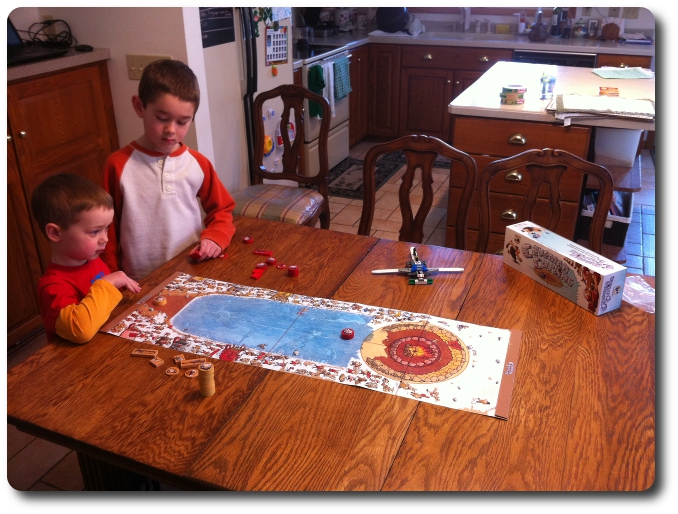
Game 3 and my oldest is watching his younger brother like a hawk - cool LEGO toy not included
Gamer Geeks, I might be loosing just about any and all geek cred I have, but I’m going to go out on a limb here and state this game is one you should play. There is great use of skill and tactics that can be utilized in the game, taking a very simple idea and turning it into a real challenge. With the adults I played with, there were times of obscene over joyous moments of pure victory only to be followed by bouts of total and complete frustration. Few games on the market provide us Gamer Geeks that type of emotional intensity and are still fun to play.
Parent Geeks, this is a fun game to play with the family and friends at your table. So much fun, expect your other games to be put to the side for a bit. Not a bad thing if you’ve been somewhat stuck playing one or two board games as of late. This game will bring a fun experience that will have everyone cheering, booing, and scrambling to play another round. Perfect for larger families and for parties where you want to introduce a unique game experience to your non-gamer friends who believe that “action games” only involve rolling dice.
Child Geeks, you are going to have so much fun with this game, but do not get frustrated or disappointed if the Rocks don’t do what you want them to. You’ll learn how to best flick those Rocks in no time and each game will become easier, but also more challenging. As you improve, so will your opponents which will make the game a constant race to see who can outmaneuver the other. When you do put that Rock in the Cave, try to remember how you flicked it and try to repeat that same motion. Each new flick is an opporutnity to try something new and get even better!
Caveman Curling is a fun and challenging game. Players shouldn’t take it seriously, even when they feel completely incompetent when they can’t put their Rocks into the Cave, ever. There is nothing terribly new here for those who have played games like Caveman Curling in the past, but nor is anything terribly bad. It’s a great mix of classic flick-action game play with a fun theme and interesting uses of special pieces. The game is a fun one and has kept my family, friends, and me engaged, frustrated, and elated over and over again. If that’s not worth two thumbs up, I don’t know what is.
This game was given to Father Geek as a review copy. Father Geek was not paid, bribed, wined, dined, or threatened in vain hopes of influencing this review. Such is the statuesque and legendary integrity of Father Geek.




Pingback: » Top This! Game Review (prepublished version)